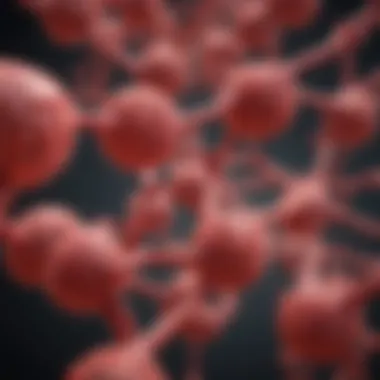Erythropoietin's Impact on Hematopoiesis and Health


Intro
Erythropoietin, commonly known as EPO, is a glycoprotein hormone predominantly produced by the kidneys. It plays a crucial role in the regulation of erythropoiesis, the process through which red blood cells are produced. Beyond its hematopoietic functions, EPO has been implicated in various physiological and pathological processes, making it a significant factor in medical research. This article will delve into the multifaceted nature of EPO, highlighting its essential role in blood production and exploring additional implications in health and disease.
Research Overview
Summary of Key Findings
Erythropoietin facilitates the production of red blood cells in response to hypoxic conditions. It acts on erythroid progenitor cells in the bone marrow, binding specifically to EPO receptors and activating signaling pathways that enhance cell survival and proliferation. Furthermore, the research indicates that EPO has potential therapeutic uses beyond anemia treatment. In particular, studies have shown EPO's capability to modulate immune responses and influence angiogenesis, which are critical in various medical conditions.
Relevance to Current Scientific Discussions
The exploration of EPO’s functions is increasingly relevant in the context of chronic diseases such as chronic kidney disease and cancer. Researchers are investigating how EPO can be harnessed to improve patient outcomes and quality of life. The evolving understanding of EPO's mechanism is contributing to discussions on its role in conditions such as type 2 diabetes and cardiovascular diseases. The implications of EPO extend beyond erythropoiesis to touch on metabolic processes and inflammatory responses, suggesting a broader biological relevance.
Methodology
Research Design and Approach
The examination of erythropoietin involves both empirical studies and clinical trials. In laboratory settings, in vitro experiments are typically conducted using hematopoietic stem cells to observe the effects of EPO on various erythroid developmental stages. These experiments often utilize cell cultures and controlled environments to isolate the influence of EPO.
Data Collection and Analysis Techniques
Data has been collected from observational studies, randomized control trials, and meta-analyses focusing on EPO administration. Statistical analysis is applied to assess the outcomes related to EPO therapy, particularly in patients suffering from anemia of chronic diseases. Measuring hemoglobin levels and red blood cell counts are common methodologies. Researchers also utilize molecular techniques to explore the signaling pathways activated by EPO to gain insight into its broader physiological effects.
Foreword to Erythropoietin
Erythropoietin (EPO) plays a critical role in hematopoiesis, primarily focused on the production of red blood cells. This hormone, produced mainly in the kidneys, serves not only to maintain adequate oxygen levels in the blood but has broader implications in various physiological processes. Understanding EPO's functions is vital for fields such as hematology, nephrology, and sports medicine.
Analyzing the role of erythropoietin provides insights into how the body responds to oxygen demands. It has important applications, especially in treating anemia and enhancing oxygen delivery in various clinical settings. EPO's involvement in cellular responses cannot be overlooked. Thus, exploring this topic helps elucidate the complex interactions between hormones and blood formation, highlighting its broad significance in health and disease.
Historical Perspective
The history of erythropoietin research dates back to the 20th century. It was first identified in the 1900s when scientists began to understand the regulatory mechanisms of red blood cell production. In 1950, EPO was linked to erythropoiesis through studies showing that its levels rise in response to hypoxia, or low oxygen levels in the blood.
In the late 1970s, researchers isolated EPO from urine. They were able to characterize its structure, leading to a breakthrough in understanding how it works. The ability to produce EPO through recombinant DNA technology in the 1980s marked a significant advancement. This development opened doors to advanced therapeutic applications, particularly in treating patients with chronic kidney disease or cancer-related anemia.
Defining Erythropoietin
Erythropoietin is a glycoprotein hormone primarily synthesized in the kidneys but also produced in smaller amounts by the liver. Its primary function is to regulate the production of red blood cells in the bone marrow. When oxygen levels decrease, the kidneys increase the production of EPO, which then stimulates erythropoiesis. This process ensures adequate oxygen delivery to tissues, which is crucial for maintaining cellular functions.
The structure of erythropoietin allows it to bind to specific EPO receptors on the surface of erythroid progenitor cells. This interaction initiates a cascade of signaling events that promote cell survival and proliferation. EPO also plays a role beyond red blood cell production, influencing various cellular processes, including apoptosis and angiogenesis in certain conditions. Understanding the precise definition and function of EPO lays the groundwork for exploring its implications in both health and disease.
Biological Functions of Erythropoietin
Erythropoietin (EPO) plays a pivotal role in the regulation of erythropoiesis, which is the production of red blood cells. Many studies highlight the necessity of EPO in maintaining adequate oxygen-carrying capacity in the blood. Besides its primary function in stimulating erythropoiesis, EPO also exhibits other biological activities, which are essential for cellular viability and various responses in the human body. Understanding these broader physiological roles of EPO can provide insights not only into hematology but also into its potential implications in other medical conditions.
Erythropoiesis Stimulation


The primary biological function of erythropoietin is the stimulation of erythropoiesis. This process begins in the bone marrow where EPO binds to its specific receptor on erythroid progenitor cells. This binding is crucial because it triggers a series of intracellular signals that promote the proliferation and differentiation of these progenitor cells into mature red blood cells.
- Hypoxia-Induced EPO Production: When oxygen levels in the blood drop, the kidneys increase the production of EPO. This adaptive mechanism aims to enhance oxygen delivery.
- Clinical Implications: The ability of EPO to stimulate red blood cell production is particularly beneficial in conditions like anemia. For instance, patients suffering from chronic kidney disease often show decreased EPO production, leading to anemia. Administering synthetic EPO can effectively raise hemoglobin levels in these patients.
- Broader Implications: EPO's role extends to the enhancement of blood viscosity, which can improve tissue oxygenation. However, if EPO levels rise excessively, it could increase the risk of thromboembolic events. Therefore, the regulation of EPO levels is critical and should be guided by clinical assessments.
Role in Apoptosis Regulation
Beyond erythropoiesis, EPO also participates in the regulation of apoptosis, or programmed cell death. This activity is not limited to erythroid cells but also affects other cell types, including neurons and endothelial cells.
- Cell Survival: EPO acts to promote cell survival during conditions of stress. For example, in the brain, EPO has neuroprotective effects that can help shield neurons during ischemic events, thereby reducing neuronal loss.
- Intracellular Mechanisms: EPO activates signaling pathways that lead to the upregulation of anti-apoptotic molecules. This action protects against various cellular stresses, making EPO a focus in research related to neurodegenerative diseases.
- Potential Therapies: Given its anti-apoptotic properties, EPO is being explored as a potential therapeutic agent in managing diseases characterized by excessive cell death, such as stroke or traumatic brain injury.
EPO is not just a hematopoietic factor; it influences various biological processes within the body, revealing its complexity beyond its classical role in erythropoiesis.
The investigation into the biological functions of erythropoietin underscores its importance in both blood health and broader physiological processes. EPO is a vital protein that plays a significant role in maintaining homeostasis in the hematological system while having implications for cellular survival across different tissues.
Mechanisms of Action
The mechanisms of action of erythropoietin (EPO) are critical in understanding its role in hematopoiesis and various physiological processes. These mechanisms provide insight into how EPO influences erythropoiesis and other cellular functions. By examining the pathways and signal transduction mechanisms EPO employs, one can appreciate its significance in both health and disease states, especially in conditions related to oxygen transport and tissue preservation.
EPO Receptor Signaling Pathways
EPO exerts its effects by binding to the erythropoietin receptor (EPOR), which is expressed on the surface of erythroid progenitor cells in the bone marrow. This binding initiates a cascade of signaling events that lead to increased red blood cell production. When EPO binds to EPOR, a conformational change occurs, leading to receptor dimerization. This is a crucial step in activating various downstream signaling pathways.
The primary pathway involved is the JAK2-STAT5 pathway. Upon dimerization, Janus kinase 2 (JAK2) is activated. JAK2 phosphorylates EPOR as well as itself, creating docking sites for the transcription factor, signal transducer and activator of transcription 5 (STAT5). Once phosphorylated, STAT5 translocates into the nucleus, where it influences the expression of genes involved in erythropoiesis.
Moreover, EPO signaling also stimulates the PI3K-AKT pathway, which is significant for cell survival and proliferation. This pathway helps protect erythroid progenitors from apoptosis, ensuring their continued development into mature red blood cells. Understanding these pathways is essential for developing therapeutic interventions for disorders involving erythropoiesis.
"EPO pathway activation is vital not only for raising red blood cell counts but also for regulating cell survival and apoptosis in erythroid progenitors."
Intracellular Response Mechanisms
The intracellular response mechanisms activated by EPO are multifaceted. These responses not only enhance erythropoiesis but also affect other cellular functions. Upon activation of EPOR, several transcription factors like STAT5 are recruited to activate target genes necessary for erythrocyte maturation. Additionally, the expression of anti-apoptotic proteins such as Bcl-xL is upregulated, reducing apoptosis and allowing progenitor cells to survive longer during their differentiation process.
EPO also induces a metabolic shift in the erythroid progenitors, enhancing their capacity to utilize glucose and increase ATP production. This metabolic adaptation is crucial, especially under conditions of low oxygen availability.
Thus, the mechanisms by which EPO acts underscore its importance in not just erythropoiesis but also broader cellular health, making it a subject of considerable interest for both basic and clinical research. As we further dissect these actions, the implications for treating anemia and other disorders involving erythropoiesis become increasingly evident.
EPO and Hematopoietic Disorders
Erythropoietin (EPO) plays a critical role in managing various hematopoietic disorders, particularly in the context of anemia. The understanding of EPO's implications in these disorders provides a foundation for treatment strategies and therapeutic approaches. EPO's primary function is to increase red blood cell production, which directly counteracts the effects of anemia. In this section, we explore how EPO is utilized in treating anemia and examine the consequences arising from its dysregulation.
EPO in Anemia Treatment
Anemia is a common condition characterized by a deficiency in the number or quality of red blood cells. It results in insufficient oxygen delivery to tissues, leading to fatigue and other symptoms. EPO is often prescribed to stimulate erythropoiesis in patients suffering from anemia, especially those with chronic kidney disease or undergoing chemotherapy. Recent clinical trials highlight its efficacy; EPO therapy can significantly improve hemoglobin levels and enhance the quality of life for patients.
- Types of Anemia Treated by EPO:
- Chronic Kidney Disease: In patients with reduced kidney function, EPO levels are often low. Administering EPO can help restore normal red blood cell production.
- Cancer-Induced Anemia: Those undergoing treatments like chemotherapy frequently experience anemia. EPO can mitigate treatment-related blood loss and enhance recovery.
- Post-Surgical Anemia: Patients undergoing major surgeries may benefit from EPO to prevent significant drops in red blood cell counts post-operation.
EPO is typically administered through injections. The dosing regimen may vary, depending on the patient's condition and response to therapy. Monitoring is essential to adjust doses and prevent complications from excessive red blood cell production, like thrombosis.


Consequences of EPO Dysregulation
Dysregulation of EPO can have severe consequences. It can lead to either insufficient production or excessive stimulation of erythropoiesis.
- Consequences of Insufficient EPO:
- Consequences of Excessive EPO:
- Excessive fatigue and weakness due to low hemoglobin levels.
- Increased risk of cardiovascular complications as tissues are deprived of adequate oxygen.
- Elevated red blood cell mass may result in increased blood viscosity.
- Higher risk for thromboembolic events, such as strokes and heart attacks.
In addition, inappropriate EPO usage in non-medical settings has led to increased scrutiny. Athletes might misuse EPO to enhance performance, raising ethical issues and prompting regulatory bodies to enforce strict anti-doping measures.
"The potential for EPO misuse underscores the necessity for strict medical guidance in its administration."
Clinical Applications of Erythropoietin
The clinical applications of erythropoietin (EPO) extend far beyond its established role in erythropoiesis. This section will discuss how EPO is utilized in various medical contexts, particularly its therapeutic implications for anemia and other hematological disorders. Understanding these applications is crucial for informing treatment strategies and optimizing patient care.
Current Therapeutic Uses
EPO is primarily recognized for its therapeutic use in treating anemia, particularly in patients suffering from chronic kidney disease, cancer, or those undergoing chemotherapy. The following points outline the current therapeutic uses of EPO:
- Anemia of Chronic Kidney Disease (CKD): Patients with CKD often experience reduced production of endogenous EPO, leading to anemia. Administering EPO can stimulate red blood cell production, alleviating symptoms of fatigue and weakness.
- Cancer-related Anemia: Cancer treatments such as chemotherapy can cause anemia. EPO therapy is used to manage this complication, improving the quality of life for these patients.
- Surgical Patients: EPO is sometimes used preoperatively in patients at risk for perioperative anemia. It prepares the patient’s body to increase red blood cell counts, thus minimizing transfusion needs during surgery.
- HIV/AIDS Patients: Those infected with HIV are at risk for anemia due to the virus or antiretroviral therapy. EPO therapies are beneficial in enhancing red blood cell production in these individuals.
In all these cases, EPO not only addresses the oxygen-carrying capacity of the blood but also significantly impacts overall patient wellbeing.
Emerging Applications in Medicine
Research continues to unveil new applications for EPO beyond its traditional use in anemia treatment. The following emerging applications show promise:
- Neuroprotection: Preliminary studies suggest that EPO may offer neuroprotective benefits. It can potentially help in conditions such as stroke or traumatic brain injury by promoting neuronal survival and cognitive function recovery.
- Cardiac Applications: Research indicates a potential benefit of EPO in heart failure management. It might enhance heart performance by improving overall blood oxygen levels and reducing cardiac workload.
- Wound Healing: Some investigations point to EPO’s role in accelerating wound healing processes, notably in diabetic patients. It may promote angiogenesis and improve tissue regeneration.
- Regenerative Medicine: Given its actions on stem cells, EPO has potential applications in regenerative medicine. Targeting stem cell pathways may improve recovery outcomes in areas such as bone marrow disorders.
In summary, the clinical applications of erythropoietin highlight its multifaceted role in medical treatment. Its impact on erythropoiesis is just one aspect of its wider potential in managing various health conditions.
"The exploration of EPO's therapeutic potential continues to evolve, with further research needed to fully unlock its capabilities in medicine."
Integrating EPO into therapeutic regimens offers both benefits and considerations that must be taken into account, such as potential side effects and the risk of overuse. Being informed about these applications allows health professionals to make better decisions tailored to individual patient needs.
EPO in Sports and Ethical Considerations
The influence of erythropoietin (EPO) extends beyond its biological role in erythropoiesis, reaching into the realm of sports. This section delves into the use of EPO among athletes and the subsequent ethical discussions that arise. Understanding this topic is crucial as it highlights the fine line between performance enhancement and unfair advantage, a concern in modern sports.
EPO Abuse in Athletics
EPO abuse in athletics has gained considerable attention for its implications on fair play and athlete health. Athletes may misuse EPO to enhance oxygen delivery to muscles, which could improve endurance and overall performance. The substance raises hematocrit levels, leading to greater oxygen transport capacity. This method of doping has become a prominent issue in various sports, especially endurance sports like cycling and long-distance running.
The dangers of EPO abuse are significant. Increased hemoglobin can raise blood viscosity, creating a risk of heart attack or stroke. Many athletes, seeking a competitive edge, fail to consider the long-term health risks associated with its misuse. Furthermore, the use of EPO can undermine the integrity of sports, as records and victories achieved through doping do not reflect true athletic ability and commitment.
"The essence of sports lies in fair competition; the introduction of performance-enhancing drugs disrupts this fundamental principle."


Ethical Implications of EPO Use
The ethical implications surrounding EPO use in sports provoke deep moral questions. Firstly, the integrity of sports is compromised when some athletes resort to doping tactics to gain an unfair advantage. This creates an uneven playing field, where natural talent and effort are overshadowed by an athlete’s willingness to use substances like EPO.
Moreover, there is the issue of coercion. In highly competitive environments, athletes may feel pressured to use EPO to keep up with peers or meet sponsorship expectations. This reflects a critical ethical dilemma: should the pursuit of excellence justify risking health and well-being?
The discussion around regulation also merits attention. Some argue for stricter regulations with more robust testing protocols to deter EPO use, while others advocate for a re-evaluation of what constitutes fair play. Incorporating education on the risks involved with EPO use into athletic training programs could foster a more informed approach to performance enhancement without jeopardizing health.
In summary, the intersection of EPO use in sports and ethical considerations underscores the complexity of maintaining fairness and athlete well-being in competitive environments. The analysis of this situation helps frame future dialogues on governance in sports and athlete health.
Future Directions in EPO Research
The exploration of erythropoietin (EPO) continues to be a significant area in medical research. As our understanding of EPO's roles expands, researchers are uncovering potential applications that go beyond hematopoiesis. Examining EPO helps not only to treat anemia and other blood disorders but also to explore its effects on various physiological processes.
It is crucial to consider innovative therapeutic approaches that can harness EPO's capabilities effectively, while addressing the challenges that may arise. The future of EPO research encompasses several elements:
- Enhanced EPO formulations: Researchers are looking into modified EPO molecules that retain efficacy while improving safety and reducing side effects.
- Targeted delivery systems: Novel methods that precisely deliver EPO can change its impact on specific tissues and diseases, potentially reducing the dosage required and minimizing unwanted effects.
- Combination therapies: Integrating EPO with other therapeutic agents or treatments may provide synergistic effects, enhancing patient outcomes in various conditions.
In summary, the future directions in EPO research are pivotal to maximize the utility of this crucial hormone. Moving forward involves addressing both specific advancements and ethical considerations surrounding EPO usage.
Innovations in EPO Therapy
Innovations in EPO therapy represent a promising shift in how we approach treatment for various hematological conditions. One significant area of innovation lies in the development of longer-acting EPO preparations. For example, Vigbex is an erythropoiesis-stimulating agent that offers extended dosing intervals, which helps improve patient compliance and convenience.
Additionally, biopharmaceutical companies are striving to create EPO variants that specifically target and stimulate different subsets of erythroid progenitor cells. This specificity could enhance the effectiveness of EPO while reducing adverse events.
Another exciting avenue of research involves the exploration of EPO-like peptides that can mimic EPO's effects without eliciting the same immune responses. Such innovations point towards a future where EPO therapy can be safer and more effective for diverse patient populations.
Potential Research Gaps
Despite the advancements in the field, several research gaps remain. One significant gap is the role of EPO in non-hematopoietic contexts. While there are indications that EPO may have neuroprotective effects, more studies are needed to clarify the mechanisms and effectiveness of EPO in neurological disorders.
Furthermore, existing studies are insufficient to fully understand EPO's impact on various cancers. Investigating the dual nature of EPO's influence on tumor growth and the microenvironment could shed light on potential therapeutic strategies.
Lastly, there is a need for a comprehensive analysis of EPO's long-term effects. Understanding the implications of prolonged EPO therapy in patients, especially in terms of tolerance and potential resistance, is crucial for safe clinical application.
Investing time and resources into these gaps will be essential for realizing EPO's complete potential in medicine.
The End
The conclusion plays a crucial role in synthesizing the information presented throughout the article, highlighting why erythropoietin is integral in hematopoiesis and its broader implications. By reflecting on the various mechanisms, clinical applications, and ethical considerations regarding EPO, we clarify its importance in both normal physiology and pathological conditions.
Understanding the multifaceted nature of EPO allows us to appreciate its influence beyond red blood cell production. It is not merely a factor in erythropoiesis but has significant roles in apoptosis regulation and various cellular responses. This broader perspective contributes to better treatment strategies in disorders related to oxygen delivery and aspects of hematopoietic disorders.
Summary of Key Points
- EPO Significance: EPO is vital for stimulating erythropoiesis and plays roles in different biological processes.
- Clinical Applications: EPO has therapeutic uses, especially in treating anemia and addressing conditions like chronic kidney disease.
- Research and Ethics: The exploration of EPO's use in sports raises ethical questions, respectively influencing public perception and regulatory actions.
- Future Prospects: Innovations in EPO therapy and understanding gaps in research point to the ongoing evolution of its applications in medicine.
Final Thoughts on EPO’s Role
Erythropoietin stands as a remarkable aspect of human physiology. Its ability to regulate erythropoiesis and influence other cellular responses establishes it as more than just a hormone. As we move forward, the continued study of EPO is essential. This will not only enhance our understanding of hematopoiesis but also inform future clinical practices and improve patient outcomes.
"EPO’s versatility makes it a critical focus in ongoing medical research, connecting the dots between basic science and therapeutic development."
Thus, recognizing EPO’s importance can lead to better health strategies and drive advancements in therapeutic applications.



